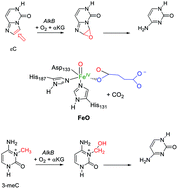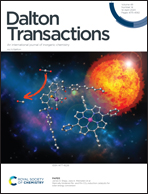Computational studies of DNA base repair mechanisms by nonheme iron dioxygenases: selective epoxidation and hydroxylation pathways†
Abstract
DNA base repair mechanisms of alkylated DNA bases is an important reaction in chemical biology and particularly in the human body. It is typically catalyzed by an α-ketoglutarate-dependent nonheme iron dioxygenase named the AlkB repair enzyme. In this work we report a detailed computational study into the structure and reactivity of AlkB repair enzymes with alkylated DNA bases. In particular, we investigate the aliphatic hydroxylation and C![[double bond, length as m-dash]](https://www.rsc.org/images/entities/char_e001.gif) C epoxidation mechanisms of alkylated DNA bases by a high-valent iron(IV)–oxo intermediate. Our computational studies use quantum mechanics/molecular mechanics methods on full enzymatic structures as well as cluster models on active site systems. The work shows that the iron(IV)–oxo species is rapidly formed after dioxygen binding to an iron(II) center and passes a bicyclic ring structure as intermediate. Subsequent cluster models explore the mechanism of substrate hydroxylation and epoxidation of alkylated DNA bases. The work shows low energy barriers for substrate activation and consequently energetically feasible pathways are predicted. Overall, the work shows that a high-valent iron(IV)–oxo species can efficiently dealkylate alkylated DNA bases and return them into their original form.
C epoxidation mechanisms of alkylated DNA bases by a high-valent iron(IV)–oxo intermediate. Our computational studies use quantum mechanics/molecular mechanics methods on full enzymatic structures as well as cluster models on active site systems. The work shows that the iron(IV)–oxo species is rapidly formed after dioxygen binding to an iron(II) center and passes a bicyclic ring structure as intermediate. Subsequent cluster models explore the mechanism of substrate hydroxylation and epoxidation of alkylated DNA bases. The work shows low energy barriers for substrate activation and consequently energetically feasible pathways are predicted. Overall, the work shows that a high-valent iron(IV)–oxo species can efficiently dealkylate alkylated DNA bases and return them into their original form.

- This article is part of the themed collection: Inorganic Reaction Mechanisms


 Please wait while we load your content...
Please wait while we load your content...